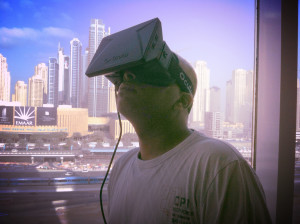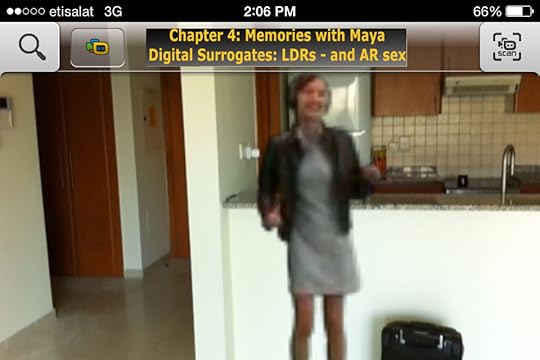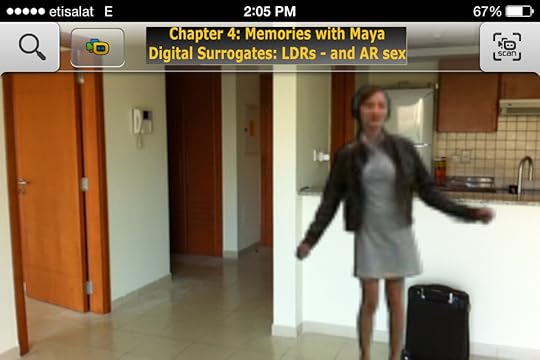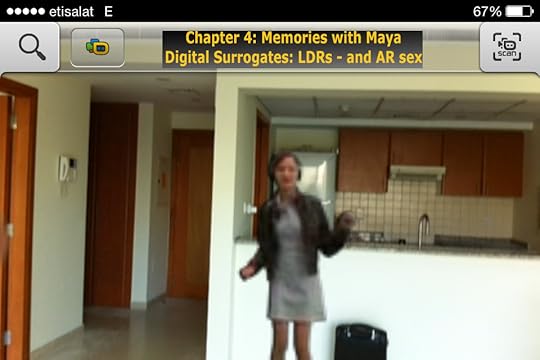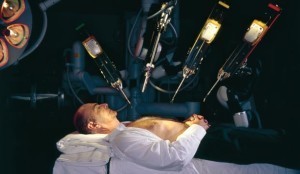Clyde DeSouza's Blog, page 6
March 25, 2014
Depth Maps of a city for Tele-Travel, extracted via Google Street view (click to read)
In Memories with Maya, Krish and Dan talk about mapping entire city blocks via real-time depth scanners atop high buildings.
These realtime depth maps can be used to construct a moving 3D “mesh” of an entire city, including people and vechicles…
The project done by Patricio Gonzalez, extracting a pointcloud via Google’s Streetview, shows a great first step towards such an eventuality – TELE-TRAVEL.
Read the GizModo article. and Patricio’s comments on how he discovered this hidden data in Google Streetview are on his vimeo page, below his video.
March 2, 2014
“Oculus Reality” – Merging our Digital lives with the real world – in real time.
Oculus Reality:
I finally got my hands on an Oculus Rift – probably the last batch to ship
The aim is to explore it’s usability for Virtual Reality Training or – ‘Serious Game’ usage in scenarios such as:
Employee orientation tours for critical locations
Emergency Shutdown Training – in virtual reality
“Oculus Reality” projects – or Digital See-through Augmented Reality – A camera captures our analog world as a digital video stream, and integrated Digital Content, presenting the final composite on the Oculus Rift HMD.
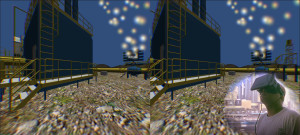
(Above: work in progress of valve shutdown simulation at an industrial site)
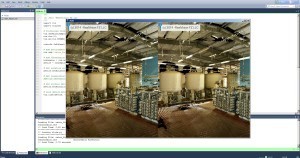
(Navigating a Point Cloud laser scan of a Water Desalination Plant on the Oculus Rift. Click for larger image)
In the hard science novel, Memories with Maya, the characters in the story devise a visor; they call it “Wizer”, and it features true see-through capability. This is not far from reality, with Google Glass being a start, and offerings from Vuzix and Meta, hold promise. As I research for the sequel to the book, the OR has already given me an interesting plot-device to use in an early chapter as the story unfolds.
Impressions:
On first wearing the Oculus Rift – the developer version- as seen in the pictures above, my impression was not overwhelming, the main culprit being the “screen door” effect, and to a lesser extent the frame update “shimmer” due to the head tracking. However, the Dev Kit comes with changeable lenses, and on swapping out the lenses for the “B-cup’ pair, the screen door effect reduced dramatically. After a few minutes, the stereo 3D immersion took over, and the wearer learns to move their head in a manner that does not produce as much shimmer or judder.
Overall, the Oculus Rift at it’s price point, offers the best VR immersion possible due to it’s large field of view. There is every reason to believe the consumer version will be a system to reckon with – in the domain of Virtual Reality gaming, simulation, education and … VR ‘intimacy’
Digital Resurrection is our Birthright – A presentation for World Future Day (March 1st 2014)
Use Arrow buttons to move to next slide, Use Mouse wheel to Zoom in, Fullscreen button to expand.
What if Humans are narrow AI, in the process of re-writing our source code?
January 30, 2014
Digital Surrogates: Tele-travel & The future of Long Distance Relationships (LDRs)
Augmented Intimacy via Digital Surrogates:
Here’s an experiment I’m working on – it’s Oculus Rift and VR on steroids – This is “Augmented Intimacy”. See and interact with your partner right in your living-room: The future of LDRs (long distance relationships).
There is a more serious – bordering on taboo- use of this tech for a person’s digital surrogate, but mentioning it would be a major spoiler for those interested in reading the book, Memories with Maya.
A quick 101:
- An iphone camera “maps” the room (in the book- Dan and Krish use a kinect like device)
- The “camera’s” position is located and any 3D object can be locked to it – in this case the Digital Surrogate of another person – augments the live camera view at correct depth.
- Wearing a See-through visor (Vuzix makes a Digital see-thru one as do others) a wearer can see another person in the room.
The book has more of the rest….
The still shots of the final AR scene above, does not do justice to the coolness of seeing her dancing in the room – live.
Dirrogate [Digital Surrogate] case scenarios:
The aim of the experiments are to gain insights into whether we might evolve into accepting Digital beings – in social interaction scenarios – the way we do with humans.
- Can a grieving person who’s lost their lover/ partner find solace interacting with a Digital re-incarnation, perhaps to help during the grieving process?
- Can a person who may be disfigured, maimed, and for other reasons NOT able to have intimate relations with another human, find a way out via their Digital Proxy?
- Can two human partners – separated due to War (Soldiers), work, or bed ridden – have an LDR via Digital Surrogates?
Next Steps:
Occlusion mapping – One scene in the book describes how a real-time 3D map is created from the Stereoscopic 3D input of the ‘Fisheye’ – the fictional version of a Kinect 2. For the demo above, if a 3D map of the room is built, the Kitchen counter will occlude correctly, parts of the 3D model of the Digital Surrogate – should she walk behind the counter
IK and AI to drive the 3D model: i.e. she could “sit” on a chair, with IK correctly taking care of skeletal deformations of the 3D model. Proximity triggers and simple AI will know when to trigger IK.
More complex AI can drive TOD (time of day) routines for the Digital Surrogate if indeed the Digital Surrogate is not being steered in real time by a human operator [tele-travelling]
Memories With Maya is a “low-level” sci-fi book, i.e the science is so hard – it can be implemented within the next few years.
A special thanks to METAIO for furthering AR. A nod in acknowledgement to Amire, who got me interested all those years ago.
January 21, 2014
Low-level Science fiction: Sci-fi with hard science and a literary slant
While the headline for the review of Memories with Maya on i09.com might border on sensationalism- it is not without merit. io9 “got” the message in the story.
Human sexuality is one of the avenues that gets upgraded via technology in Memories with Maya, but the very essence of what makes us human – our emotions, our ability to make the intangible…tangible, by the plasticity of our minds and via technology- is what the story is about. Hard science fiction aims to present plausible science and scenarios to seed ideas in readers of the genre – many of whom have more than a passing interest in the fields of science and philosophy.
What is Low-Level Science Fiction?
Memories with Maya is an attempt to create a niche in Hard Sci-fi, and borrows a term from computer language programming: “Low level coding”
Some aims of Low level Sci-fi are:
To present current technology and extrapolate to near future tech, in the form of story – thus accelerating the idea seeding process for people of science, encouraging them to investigate and implement scenarios described in a Lo-lev Sci-fi novel.
Creatively present with as much detail as possible, the implementation of said technology- while avoiding long info-dumps and contrived ‘literary devices’ to explain the tech – The art of crafting compelling low level sci-fi stories.
Activate low level circuits in a readers mind with one’s prose, akin to how literary works of the past did. Lo-lev Sci-fi is hard Sci-fi with a literary slant. Too many of today’s sci-fi novels rely on formulaic writing, resorting to “cliff hangers” and thrills at the expense of plausible science and food for thought.
Trim fluff – when necessary- by subscribing to the Hemingway school of writing. Reading habits are changing in the 21st century as is the very definition of a “book”.
Success for a low level sci-fi novel is: Deployment, within a decade – of an original scenario or technology presented in the story.
Low level Sci-fi, unlike Mundane Sci-fi, is not against FTL travel – or Worm holes. After all, what used to once be termed science fiction, is soon becoming reality at an exponential pace.
The above is not a manifesto as much as it is a call for the creation of a sub genre of Science-Fiction whose main goal is to accelerate the transcendence of humanity.
Memories with Maya – A Low-Lev Sci-fi Novel:
While the story is not for the casual book lover, it is not surprising that a growing number of readers who looked deeper…found the low-level message(s) in Memories with Maya:
Joe Nickence, a writer at the Institute for Ethics and Emerging Technologies (IEET) wrote in an essay titled : Till Death do us part – The ethics and evolution of Human relationships:
“…A person bed-ridden can use his or her Dirrogate [Digital Surrogate] to interact with a partner is another example. Or, as Ray Kurzweil, the love of a child for a parent. I’m sure you can point out many widows and widowers that had lost the will to continue after the death of their love.”
Ann Reynolds, writing for the Huffington Post shows the idea seeding potential that a lo-lev Sci-fi novel can have in an astute reader:
“…The implications of Wizer technology as a transmitter of hertz frequency to the brain is the most compelling idea I’ve had from all this. A Wizer with two cameras could transmit ultrasound that produces bursts of light at neuron sites, thereby causing growth of cells holographically.”
Giulio Prisco – Noted Futurist and Transhumanism editor at KurzweilAI, after reading MwM commented in his review:
“If your body died, but you had a mindclone, you would not feel that you personally died, although the body would be missed more sorely than amputees miss their limbs.” I think it would be very cool to combine this concept with the advanced augmented-reality technology described in the novel.
John Havens – writing on the topic of AI for popular site Mashable, in an essay titled: “You should be afraid of Artificial Intelligence” :
“…The book [Memories with Maya] imagines life’s repercussions if we could essentially keep our loved ones alive beyond the time their bodies physically stop functioning.”
Perhaps, Kevin Russell – Futurist, sums it up well on what Low-Level Scifi could do for Science fiction, when he wrote in his review of the book:
“…As a futurist I am constantly confronted with how people perceive and react to many concepts regarding the future. People hear about a new discovery or technology and default to what they have seen in a movie or read in a book. In talking about Artificial Intelligence, most, reflexively think about Skynet from Terminator.
My hope is people will default to well thought-out, technologically grounded, futuristic sci-fi.”
Low level science fiction might not be for every Fantasy/Sci-fi book lover, but there is a growing legion of connoisseurs who are discovering the joys of geeking out on Lo-Lev Sci-fi.
A sampling below:
December 26, 2013
Will AI evolve from HAI – Human Augmented Intelligence (click :here: to read)
For the record, I don’t think that the emergence of Strong AI will be a doomsday – Armageddon scenario.
I am personally intrigued and excited to know what our future world is, with AI.
My thoughts in the text on the title image, are what I believe might happen in the coming decades – Humans integrating narrow Ai into themselves in the form of sensors/devices (even at the Nano-bot level) that monitor the well-being of the human owner…
Also, think of Google Glass – Augmented Intelligence is what such a device offers – The ability to instantly draw up information and knowledge from the cloud and present it within the field-of-view of the wearer - In effect we are offloading our brains (at least the information retrieval part) to another substrate.
This makes Human Augmented Intelligence (HAI) more likely to come about faster than typical AGI.
Now – the “rogue” part of what I believe might occur, – the evolution of such HAI into “Artificial Intelligence” – or Ai devoid of human ownership.
Consider the narrow Ai present in the nano-bots mentioned above – it can for instance, be monitoring neural activity, mapping every synapse that fires in the human owner in response to external stimuli, dreams, thoughts, for the well being of the human owner (say in therapy for Alzheimer’s patients)… now what if such narrow Ai goes “rogue” maybe via initial intervention by a mad-scientist/hacker – [heck, even the NSA had backdoors in supposedly secure encryption solutions aimed at the public] – and via learning and re-programming itself… … …
That, in my belief, is how HAI might evolve into true artificial intelligence – AI that does not need a human owner, a human “host”
AI versus HAI – Human Augmented Intelligence (click title to read)
For the record, I don’t think that Ai will be a doomsday – Armageddon scenario.
I am personally intrigued and excited to know what our future world is, with Ai .
My thoughts in the text on the title image, are what I believe might happen in the coming decades – Humans integrating narrow Ai into themselves in the form of sensors/devices (even at the Nano-bot level) that monitor the well-being of the human owner…
Also, think of Google Glass – Augmented Intelligence is what such a device offers – The ability to instantly draw up information and knowledge from the cloud and present it within the field-of-view of the wearer - In effect we are offloading our brains (at least the information retrieval part) to another substrate.
This makes Human Augmented Intelligence (HAI) more likely to come about faster than typical AGI.
Now – the “rogue” part of what I believe might occur, – the evolution of such HAI into “Artificial Intelligence” – or Ai devoid of human ownership.
Consider the narrow Ai present in the nano-bots mentioned above – it can for instance, be monitoring neural activity, mapping every synapse that fires in the human owner in response to external stimuli, dreams, thoughts, for the well being of the human owner (say in therapy for Alzheimer’s patients)… now what if such narrow Ai goes “rogue” maybe via initial intervention by a mad-scientist/hacker – [heck, even the NSA had backdoors in supposedly secure encryption solutions aimed at the public] – and via learning and re-programming itself… … …
That, in my belief, is how HAI might evolve into true artificial intelligence – Ai that does not need a human owner, a human “host”
December 18, 2013
Minimally invasive Medical Technology – For the betterment of the Human condition.
Technology for pain-free healing:
“Your threshold for pain is near zero”, said my dentist, as she deftly moved the extremely thin fiber optic laser head away.
“That’s why I chose to fly in here. Gum filet carving doesn’t appeal to me”, I mumbled, my lips feeling leathery from the anesthetic spray.
There was a mild tingling as the laser killed millions of enemies under my gum-line. I lay back in the chair and considered the alternative I was presented only a day ago by an over enthusiastic periodontist – A scalpel and suture gum flap procedure for “deep cleaning.”
‘This is 2013′, I had thought to myself. ‘There has to be a less primitive way… a less painful solution.’
12 hours later, with 25 browser windows open and an estimated further 40 websites bookmarked, I was sure I had enough information to consider writing a thesis on pain free dentistry – The answer, I concluded, was LANAP. I delved deep into the pros and cons of laser dentistry procedures, understanding OPG xrays, doing comparisons and reading on soft tissue lasers, diode lasers, wave-lengths and even the patent wars of companies spearheading the future of medical technology.
The Transhumanist Patient:
Doctors have it hard today and I genuinely sympathize with them- to a certain degree. After all, every person has access to the internet but not everyone knows how to distill this ‘open source knowledge’ effectively. So doctors stand to lose patients and patience, when catering to the whims of clients walking into their clinics.
Yet, we are in the midst of an information and knowledge explosion and if doctors rely only on a degree earned about a decade ago or even 3 years ago, while not immersing themselves in the accelerating changes in technology and discoveries in their field, they will encounter a patient who will challenge or at the very least – question such a doctor’s line of diagnosis and treatment.
I learned the following:
Ask for a 3rd opinion – That second-opinion should be one’s own obligation, using the internet as an interactive medical encyclopedia to thoroughly understand the ailment.
A medical practitioner who does not have access to the latest in medical technology and/or has not updated their skill-set in the usage of such, will lose out.
Tele-medicine is the future.
Services such as Medcarelive, that offer a flavor of tele-medicine is just the start. Competition will soon catch-up and there is no doubt that the smart phone will truly become ubiquitous with personal healthcare. Devices such as Google Glass are already providing healthcare professionals with real time updates of patients vital information.
A smart phone coupled to such wearable technology could transform such a visor – into a Wizer – the fictional device from the story Memories with Maya.
Apps for the Smart phone, running sophisticated software and processing algorithms can harness common sensors in the device such as the Microphone to analyze or transmit the patient’s cough or voice. There’s even a possibility to do ultra-sound imaging with an add-on peripheral. High resolution cameras can transmit detailed imagery and videos for remote diagnostics – and possibly in real-time in some scenarios with tele-medicine.
The Transhumanist Doctor:
A medical professional who has a genuine love for learning and keeping abreast with technology in his/her field of practice is by very definition – a Transhumanist. Such professionals may not even know of their transhumanist leanings, but by putting into practice what some Transhumanist fashionistas only preach about, a transhumanist doctor is doing actual ground work to better a patients condition, using science and technology. One such (highly respected) person is Dr. Eric Topol and the strides he’s made with his contribution to Wireless Medicine
To be true to the medical profession in this age, one needs to be highly trained and competent in the use of advanced medical technology – Simply attending a 101 or a couple of seminars and training sessions on use of robotic surgery equipment for instance, can lead to severe accidents and can stall the progress of the very technology that we seek to make mainstream.
There are downsides to be aware of if medical practitioners are not thorough in their training and in their own follow-up research in related fields. For example: Should a dentist or surgeon be studying more about lasers in-depth than the system and controls that are present on the console they are using? I would argue yes they should. Learning as much as possible about types of laser, pulse duration, power and even the very type of laser to use for different soft/hard tissue procedures is an important factor that should not be ignored. In robotic surgery systems, should surgeons understand the degree of motion scaling and tremor reduction systems? Just as a true camera professional might learn how much his/her camera lens ‘breathes’, so too should a surgeon be keen on in-depth learning about the technology and tools they are using.
In keeping with the ethics of such emerging technology, it is only appropriate to mention the many ‘accidents’ that have occurred with even the very advanced minimally invasive DaVinci Robotic Surgery system. The video is worth the approx 10 minutes viewing time. Full link to report :here:
The home of 2025 – Kitchen, living-room, bedroom and the MedPod room:
Medical technology has to become affordable, if our quest to better the human condition is to succeed. Pain free or minimally invasive medicine should not only be for the rich. While it is true that private corporations are investing in the manufacture of these systems and thus earn the right to profit from their deployment, access to advanced medicine should be the right of every person - else we run the risk of an Elysium like future.
With smart phones already being deployed in medical diagnostics, it won’t be long before personal health pods find a place in homes. Such systems might allow for remote tele-medicine or even remote human assisted surgery to become reality. After all, in the DaVinci Robotic Surgery system, it does not matter if the surgeon is sitting a few feet away at his master console or… across town.
Desktop 3D printed Pharmacies:
Desktop 3D Printing Pharmacies could print out capsules / pills on-demand, or drones could deliver a prescription from a local pharmacy right to one’s door-step.
The future looks good for pain free healing of the human body – and it is up to us to make such technology accessible and affordable.
October 22, 2013
Huffington Post - Memories With Maya is a magic carpet ride...
I got my own personal shot of awe when author Clyde DeSouza asked me to review his "sci-fi" novel, Memories With Maya. He pulls an epic amount of research into his storyline on augmented eyeglass technology and visorwear. In his novel, two friends invent the AR/AGI Wizer, and add sensory haptics for a remote interface experience, so that full-body enhancement is "fleshed out" with a friend of your choice.
DeSouza goes even further, by suggesting memories in the brain of lost loved ones can be uploaded into Wizer, where they are retrieved "from the dead." They become dearly beloved "dirrogates," and their memory "lives on," thanks to the non-referential locality of memory in the brain. When a virtual marriage took place several years ago, the digital world blessed the union. The groom couldn't live without his Second Life virtual partner, so he married her.
DeSouza's book sent me on a nomadic techno-journey across digital territory for weeks. Now I was late publishing his review, but I couldn't help myself. My brain, hijacked by millions of neurons, was feeding off the unlimited supply of high-carb links DeSouza sent, which included inventors of 3D/AGI visor/ eyewear that I could actually buy without a prescription or even a special invite.
read the whole review on The Huffington Post


